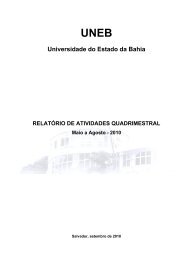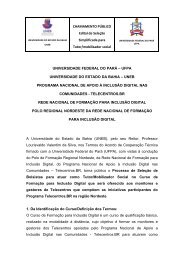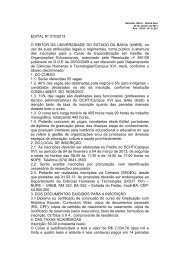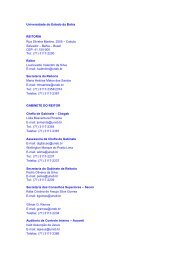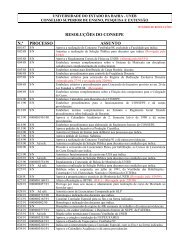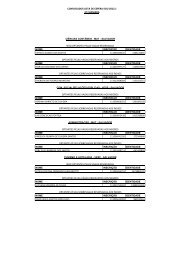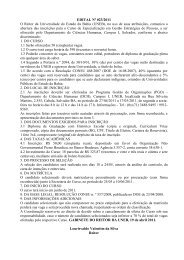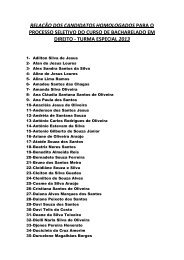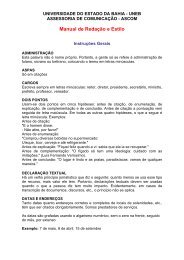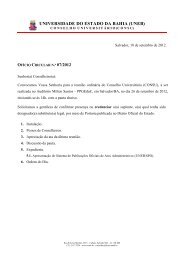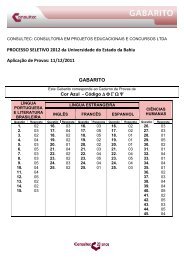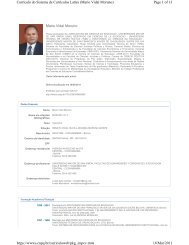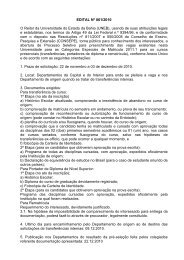Revista da FAEEBA Educação e Contemporaneidade - Uneb
Revista da FAEEBA Educação e Contemporaneidade - Uneb
Revista da FAEEBA Educação e Contemporaneidade - Uneb
You also want an ePaper? Increase the reach of your titles
YUMPU automatically turns print PDFs into web optimized ePapers that Google loves.
Latina/os are by definition adept border crossers<br />
and border straddlers. They cross racial<br />
borders, cultural borders, language borders, physical<br />
borders. They re-invent themselves as “not<br />
neither,” as Sandra Maria Esteves (1984, p.26)<br />
puts it, continuing to maintain their claims to the<br />
right to distinctive identities, to exist in the “borderlands.”<br />
Those “borderlands” are visible in<br />
contemporary Latina/o literatures and the arts.<br />
Chicano artist and social critic Guillermo Gómez-<br />
Pena, poet Sandra Maria Esteves, Chicana activist<br />
and author Gloria Anzaldua, Nuyorican<br />
ethnographer Juan Flores, all examine and embrace<br />
“the ‘Border’ – everything that represents<br />
the interpenetration of social formations and stands<br />
between simple choice of national identity –<br />
as a distinctively Latino and dialectical epistemology”<br />
(DAVIS, 2001, p.18).<br />
Being Puertorriqueña<br />
Americana<br />
Born in the Bronx, not really jíbara 23<br />
Not really hablando bien<br />
But yet, not gringa either. (SANDRA MARIA<br />
ESTEVES, Not neither, 1984)<br />
Creatively playing with English and Spanish,<br />
Guillermo Gómez-Pena reflects in his artistic<br />
manifesto on what “The Border Is” (1993):<br />
Border culture means boycott, complot, ilegali<strong>da</strong>d,<br />
clandestini<strong>da</strong>d, contrabando, transgression<br />
desobediencia binacional…<br />
But it also means transcultural friendship and collaboration<br />
among races, sexes, and generations.<br />
But it also means to practice creative appropriation,<br />
expropriation, and subversion of dominant<br />
cultural forms.<br />
But it also means a multiplicity of voices away<br />
from the center, different geo-cultural<br />
relations among more culturally akin regions….<br />
But it also means regresar, volver y partir: to return<br />
and depart once again . . .<br />
But it also means a new terminology for new<br />
hybrid identities and métiers<br />
Constantly metamorphosizing….<br />
To live in these borderlands can be painful,<br />
and Anzaldúa (1987, p.2-3) paints vivid images<br />
of that pain with words:<br />
1,950 mile-long open wound<br />
dividing a pueblo, a culture,<br />
Ellen Bigler<br />
running down the length of my body,<br />
staking fence rods in my flesh,<br />
splits me splits me<br />
me raja me raja<br />
This is my home<br />
this thin edge of<br />
barbwire.<br />
[This open wound that is the U.S./Mexican<br />
border is]<br />
… where the Third World grates against the first<br />
and bleeds. And before a scab forms it hemorrhages<br />
again, the lifeblood of two worlds merging<br />
to form a third country – a border culture.<br />
Straddling that border, poet Aurora Levins<br />
Morales sees the emergence of a new hybrid<br />
self, and can affirm her “wholeness”:<br />
I am a child of the Americas<br />
a light-skinned mestiza of the Caribbean<br />
a child of many diaspora, born into this continent<br />
at a crossroads.<br />
I am not african. Africa is in me, but I cannot<br />
return.<br />
I am not taína. Taíno is in me, but there is no way<br />
back.<br />
I am not european. Europe lives in me, but I have<br />
no home there.<br />
I am new. History made me. My first language<br />
was spanglish.<br />
I was born at the crossroads and I am whole.<br />
(1986, p.50)<br />
Latina/os have challenged traditional<br />
analytical frames that assume they will travel<br />
a unilinear path of language and cultural<br />
loss, cultural identity shift, and disappearance<br />
into the larger social body. This is in part<br />
an outcome of their unique histories in a racialized<br />
society. It is in part a response to the<br />
differing conditions of contemporary immigration<br />
and the economic restructuring in a globalizing<br />
society that favors bi-national or<br />
transnational identities. It is in part the product<br />
of a series of endless choices they make<br />
and the stories they tell themselves and others.<br />
As Stuart Hall reminds us, identity is “‘production,’<br />
which is never complete, always in<br />
23 “Jibara” is a term used in Puerto Rico to reference the<br />
“genuine” Puerto Rican. In the past it meant someone who<br />
was a “country bumpkin.”<br />
<strong>Revista</strong> <strong>da</strong> <strong>FAEEBA</strong> – <strong>Educação</strong> e Contemporanei<strong>da</strong>de, Salvador, v. 15, n. 25, p. 239-257, jan./jun., 2006 253



